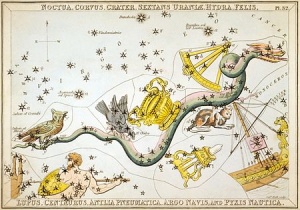Hydra

Hydra is the largest of the 88 modern constellations, measuring 1303 square degrees. Also one of the longest at over 100 degrees, its southern end abuts Libra and Centaurus and its northern end borders Cancer.It has a long history, having been included among the 48 constellations listed by the 2nd century astronomer Ptolemy. It is commonly represented as a water snake. It should not be confused with the similarly named constellation of Hydrus. [1]
Despite its size, Hydra contains only one reasonably bright star, Alphard, designated Alpha Hydrae. It is an orange giant of magnitude 2.0, 177 light-years from Earth. Its traditional name means "the solitary one". Beta Hydrae is a blue-white star of magnitude 4.3, 365 light-years from Earth. Gamma Hydrae is a yellow giant of magnitude 3.0, 132 light-years from Earth. [2]
Messier Objects
Hydra contains three Messier objects. Messier 83, also known as the Southern Pinwheel Galaxy, is located on the border of Hydra and Centaurus, Messier 68 is a globular cluster near Messier 83, and Messier 48 is an open star cluster in the western end of the serpent.[1] NGC 3242 is a planetary nebula of magnitude 7.5, 1400 light-years from Earth. Discovered in 1785 by William Herschel, it has earned the nickname "Ghost of Jupiter" because of its striking resemblance to the giant planet. Its blue-green disk is visible in small telescopes and its halo is visible in larger instruments. Messier 48 (NGC 2548) is an open cluster that is visible to the naked eye under dark skies. Its shape has been described as "triangular"; this 80-star cluster is unusually large, more than half a degree in diameter, larger than the diameter of the full Moon. [3]
There are many other galaxies located in Hydra. NGC 3314, usually delineated as NGC 3314a and NGC 3314b, is a pair of galaxies that appear superimposed, despite the fact that they are not related or interacting in any way. The foreground galaxy, NGC 3314a, is at a distance of 140 million light-years, and is a face-on spiral galaxy. The background galaxy, NGC 3314b, is an oblique spiral galaxy, and has a nucleus that appears reddened because of NGC 3314a's dusty disk.
Legend

The Greek constellation of Hydra is an adaptation of a Babylonian constellation: the MUL.APIN includes a "serpent" constellation (MUL.DINGIR.MUŠ) that loosely corresponds to Hydra. It is one of two Babylonian "serpent" constellations (the other being the origin of the Greek Serpens), a mythological hybrid of serpent, lion and bird. The shape of Hydra resembles a twisting snake, and features as such in some Greek myths. One myth associates it with a water snake that a crow served Apollo in a cup when it was sent to fetch water; Apollo saw through the fraud, and angrily cast the crow, cup, and snake, into the sky. It is also associated with the monster Hydra, with its many heads, killed by Hercules, represented in another constellation. According to legend, if one of the hydra's heads was cut off, two more would grow in its place. However, Hercules burned out the roots of the heads he severed to prevent them from growing again, and thus overcame the hydra.[4]
The Hydra of Lerna was a fabulous water serpent with nine heads, killed by Hercules in the second of his twelve labors. Hercules found that if he cut off one of the heads, two new heads grew back: hence some evils are spoken of as "many headed hydras". Hercules' nephew and charioteer, Iolaus, used a burning firebrand to scorch the neck stumps after each decapitation, and Hercules buried the ninth head, the one that was immortal, under a huge stone. The expression "hydra-headed" refers to a weed or trouble that is very difficult to get rid of.
This constellation represents the Hydra of Lerna. The name Lerna resembles the word learn. An ichnite is a fossilized footprint, the imprint of the sole of the foot. The myth says "even smelling the Hydra's footprints was enough to bring death to an ordinary mortal". It was while battling the Hydra that Hercules crushed the Crab (Cancer) under the sole of his foot. The essence of the verb 'to learn' comes from the idea of following tracks, "to follow a course of study", "gain experience by following a track". The word learn comes from the Indo-European root *leis-¹ 'Track, furrow'. Derivatives: last³ (a block or form shaped like a human foot and used in making or repairing shoes. To mold or shape on a last, last, sole of the foot), last² (to continue in time), lore¹, learning, learn (to follow a course of study'), delirium (mental confusion, a going off the ploughed track, a madness, from Latin lira, a furrow).[5]
HGS Session References
HGS Sessions - Clearing Dragon Moth Grid - 3/10/2015 [6]
HGS Sessions - Clearing Dorado, Leo Minor, Musca, Perseus constellations - 3/23/2015 [7]
References
Found in HGS Manual on Page 108
Found in HGS Manual on Page 115

